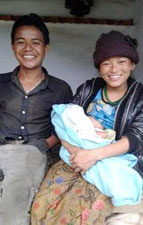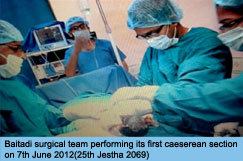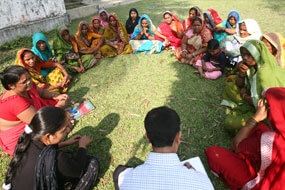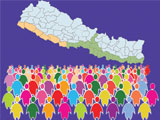Success Stories
Celebration and Tragedy: Why Maternal Health Services in Remote Areas Need Strengthening
Case Study 1: Baby Limbu Survives Due to the Efforts of Lingkhim Health Post
Twenty-one year Kabila Limbu of Khejenim 3, Taplejung, eastern Nepal became pregnant for the first time in June 2014. She attended regular antenatal check-ups at her local health post at Lingkhim from the fourth month of her pregnancy after her interaction with the local social mobiliser. Her labour pains began at 5am on 19 March 2015 and her husband and in-laws took her to the birthing centre at Lingkhim Health Post.
She was admitted at midday complaining of the normal labour symptoms of lower abdominal pain, backache and vaginal discharges. I (the auxiliary nurse-midwife, ANM) found the condition of the mother and foetus to be normal. The foetal heart rate was regular at 140 beats per minute and the mother’s cervix was open at 8cm wide. She had good regular and strong contractions. My only concern was that the baby’s head was high. We closely monitored the mother and baby.
Case Study 2: Basanti Died Soon after Giving Birth
The importance of improving access to MNH services was brought home to the project team by a women dying in child birth in one of the project’s VDCs in January 2015. This was a tragic lesson for the project of a woman who was not reached.
A woman in the equity and access programme (EAP) area had married when she was only 14 years old. She had a difficult marriage as her husband often got drunk, her in-laws were not supportive and her first child died at four days old.
In 2014 the RAMP social mobiliser came to know that the now 18-year old woman was pregnant with her second child. She had not been participating in the RAMP MNH awareness raising meetings. The mobiliser went to her home in September 2014 and after a long discussion she admitted that she was six months pregnant. She was alone as her husband and in-laws were in Jhapa district on their personal work, a day’s bus ride away.
SAVING MOTHERS AND NEONATES:
 When Dr Guna Raj Awasthi was posted as DHO to Baitadi, Far Western Region in 2011, he was frustrated by what he found. The district hospital lacked a comprehensive emergency obstetric and newborn care centre to manage complicated deliveries and many mothers and newborns were dying each year during delivery.
When Dr Guna Raj Awasthi was posted as DHO to Baitadi, Far Western Region in 2011, he was frustrated by what he found. The district hospital lacked a comprehensive emergency obstetric and newborn care centre to manage complicated deliveries and many mothers and newborns were dying each year during delivery.
Driven on by a passion to serve people in remote and Underserved areas, Dr Awasthi resolved to change this, recollecting "I didn't want to see any mother or child die because of obstetric complications".
Dr. Awasthi then set out on a tireless campaign to bring services to the people. He lobbied and networked extensively with national and district stakeholders. He filled vacant staffing positions and persuaded the hospital management committee to adopt CEONC services as its top priority. He succeeded in securing essential equipment and supplies from the Ministry of Health and Population and the Prime Minister's Office.
Eighteen months on, the CEONC facility is now fully and saving the lives of people like Kamala Tamata.(see attached PDF for story)
Lesson Learned? Personal leadership and a passion to serve can overcome even the most difficult of hurdles!
SOCIAL AUDITING:
 As a new, more democratic political era opens in Nepal, the demand for greater citizen participation and better governance is growing. Government and civil society are pushing for more transparent and accountable government, and social accountability tools like social audits are being introduced. Over the past two years, the Department of Health Services (DOHS) has begun implementing two different social audit approaches and guidelines. The first─linked to the Aama Programme (formerly the Safe Delivery Incentive Programme)─was developed by the Family Health Division of MoHP. The second, which takes a broader look at health service provision, was developed by the Management Division.
In order to harmonise social auditing in Nepal’s public health sector, the Primary Health Care Revitalisation Division led a review of the different approaches being used in the health and social sectors, while drawing on experience from the South Asia region. Aided by this evidence-based review of practice and consultations with key stakeholders, DOHS plans to develop a harmonised approach for subsequent piloting and scaling up.
As a new, more democratic political era opens in Nepal, the demand for greater citizen participation and better governance is growing. Government and civil society are pushing for more transparent and accountable government, and social accountability tools like social audits are being introduced. Over the past two years, the Department of Health Services (DOHS) has begun implementing two different social audit approaches and guidelines. The first─linked to the Aama Programme (formerly the Safe Delivery Incentive Programme)─was developed by the Family Health Division of MoHP. The second, which takes a broader look at health service provision, was developed by the Management Division.
In order to harmonise social auditing in Nepal’s public health sector, the Primary Health Care Revitalisation Division led a review of the different approaches being used in the health and social sectors, while drawing on experience from the South Asia region. Aided by this evidence-based review of practice and consultations with key stakeholders, DOHS plans to develop a harmonised approach for subsequent piloting and scaling up.
Case Study 1: Baby Limbu Survives Due to the Efforts of Lingkhim Health Post

Twenty-one year Kabila Limbu of Khejenim 3, Taplejung, eastern Nepal became pregnant for the first time in June 2014. She attended regular antenatal check-ups at her local health post at Lingkhim from the fourth month of her pregnancy after her interaction with the local social mobiliser. Her labour pains began at 5am on 19 March 2015 and her husband and in-laws took her to the birthing centre at Lingkhim Health Post.
She was admitted at midday complaining of the normal labour symptoms of lower abdominal pain, backache and vaginal discharges. I (the auxiliary nurse-midwife, ANM) found the condition of the mother and foetus to be normal. The foetal heart rate was regular at 140 beats per minute and the mother’s cervix was open at 8cm wide. She had good regular and strong contractions. My only concern was that the baby’s head was high. We closely monitored the mother and baby.
Case Study 2: Basanti Died Soon after Giving Birth
The importance of improving access to MNH services was brought home to the project team by a women dying in child birth in one of the project’s VDCs in January 2015. This was a tragic lesson for the project of a woman who was not reached.
A woman in the equity and access programme (EAP) area had married when she was only 14 years old. She had a difficult marriage as her husband often got drunk, her in-laws were not supportive and her first child died at four days old.
In 2014 the RAMP social mobiliser came to know that the now 18-year old woman was pregnant with her second child. She had not been participating in the RAMP MNH awareness raising meetings. The mobiliser went to her home in September 2014 and after a long discussion she admitted that she was six months pregnant. She was alone as her husband and in-laws were in Jhapa district on their personal work, a day’s bus ride away.
SAVING MOTHERS AND NEONATES:
 When Dr Guna Raj Awasthi was posted as DHO to Baitadi, Far Western Region in 2011, he was frustrated by what he found. The district hospital lacked a comprehensive emergency obstetric and newborn care centre to manage complicated deliveries and many mothers and newborns were dying each year during delivery.
When Dr Guna Raj Awasthi was posted as DHO to Baitadi, Far Western Region in 2011, he was frustrated by what he found. The district hospital lacked a comprehensive emergency obstetric and newborn care centre to manage complicated deliveries and many mothers and newborns were dying each year during delivery. Driven on by a passion to serve people in remote and Underserved areas, Dr Awasthi resolved to change this, recollecting "I didn't want to see any mother or child die because of obstetric complications".
Dr. Awasthi then set out on a tireless campaign to bring services to the people. He lobbied and networked extensively with national and district stakeholders. He filled vacant staffing positions and persuaded the hospital management committee to adopt CEONC services as its top priority. He succeeded in securing essential equipment and supplies from the Ministry of Health and Population and the Prime Minister's Office.
Eighteen months on, the CEONC facility is now fully and saving the lives of people like Kamala Tamata.(see attached PDF for story)
Lesson Learned? Personal leadership and a passion to serve can overcome even the most difficult of hurdles!
SOCIAL AUDITING:
 As a new, more democratic political era opens in Nepal, the demand for greater citizen participation and better governance is growing. Government and civil society are pushing for more transparent and accountable government, and social accountability tools like social audits are being introduced. Over the past two years, the Department of Health Services (DOHS) has begun implementing two different social audit approaches and guidelines. The first─linked to the Aama Programme (formerly the Safe Delivery Incentive Programme)─was developed by the Family Health Division of MoHP. The second, which takes a broader look at health service provision, was developed by the Management Division.
In order to harmonise social auditing in Nepal’s public health sector, the Primary Health Care Revitalisation Division led a review of the different approaches being used in the health and social sectors, while drawing on experience from the South Asia region. Aided by this evidence-based review of practice and consultations with key stakeholders, DOHS plans to develop a harmonised approach for subsequent piloting and scaling up.
As a new, more democratic political era opens in Nepal, the demand for greater citizen participation and better governance is growing. Government and civil society are pushing for more transparent and accountable government, and social accountability tools like social audits are being introduced. Over the past two years, the Department of Health Services (DOHS) has begun implementing two different social audit approaches and guidelines. The first─linked to the Aama Programme (formerly the Safe Delivery Incentive Programme)─was developed by the Family Health Division of MoHP. The second, which takes a broader look at health service provision, was developed by the Management Division.
In order to harmonise social auditing in Nepal’s public health sector, the Primary Health Care Revitalisation Division led a review of the different approaches being used in the health and social sectors, while drawing on experience from the South Asia region. Aided by this evidence-based review of practice and consultations with key stakeholders, DOHS plans to develop a harmonised approach for subsequent piloting and scaling up.





